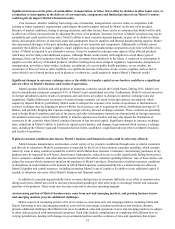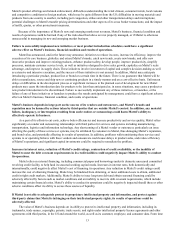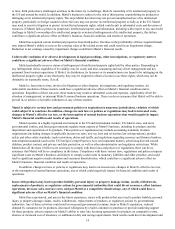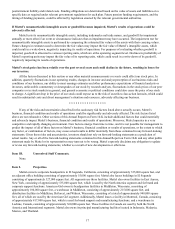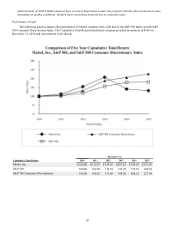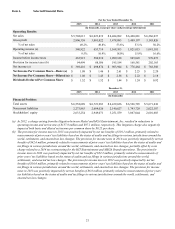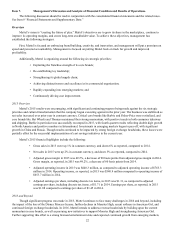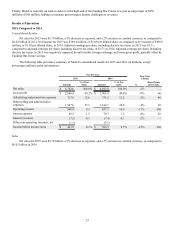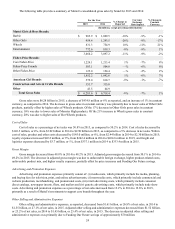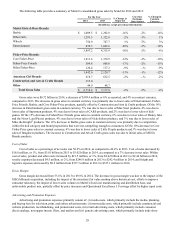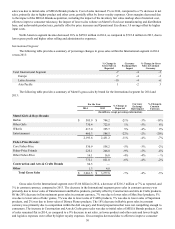Mattel 2015 Annual Report Download - page 26
Download and view the complete annual report
Please find page 26 of the 2015 Mattel annual report below. You can navigate through the pages in the report by either clicking on the pages listed below, or by using the keyword search tool below to find specific information within the annual report.22
Item 7. Management's Discussion and Analysis of Financial Condition and Results of Operations.
The following discussion should be read in conjunction with the consolidated financial statements and the related notes.
See Item 8 “Financial Statements and Supplementary Data.”
Overview
Mattel’s vision is “creating the future of play.” Mattel’s objectives are to grow its share in the marketplace, continue to
improve its operating margins, and create long-term stockholder value. To achieve these objectives, management has
established the following strategies:
First, Mattel is focused on embracing brand building, creativity, and innovation, and management will put a premium on
speed and personal accountability. Management is focused on putting Mattel back on track for growth and improved
profitability.
Additionally, Mattel is organizing around the following six strategic priorities:
• Exploiting the franchise strength of its core brands;
• Re-establishing toy leadership;
• Strengthening its global supply chain;
• Achieving distinctiveness and excellence in its commercial organization;
• Rapidly expanding into emerging markets; and
• Continuously driving cost improvement.
2015 Overview
Mattel’s 2015 results were encouraging, with significant and continuing progress being made against the six strategic
priorities and cultural transformation that the company began executing against in the prior year. The business was stabilized as
net sales increased over prior year in constant currency. Critical core brands like Barbie and Fisher-Price were revitalized, and
core brands like Hot Wheels and Thomas maintained their strong momentum, with positive trends in both consumer takeaway
and shipping. Barbie in particular was successfully revamped in 2015, with fourth quarter results reflecting double digit growth
in North America and positive numbers in International. Investments in emerging markets began to pay off, with significant
growth in China and Russia. Though results continued to be impacted by strong foreign exchange headwinds, these losses were
partially offset by the successful implementation of cost savings initiatives in the current year.
Mattel’s 2015 financial highlights include the following:
• Gross sales in 2015 were up 1% in constant currency, and down 6% as reported, compared to 2014.
• Net sales in 2015 were up 2% in constant currency, and down 5% as reported, compared to 2014.
• Adjusted gross margin in 2015 was 49.2%, a decrease of 90 basis points from adjusted gross margin in 2014.
Gross margin, as reported, in 2015 was 49.2%, a decrease of 60 basis points from 2014.
• Adjusted operating income in 2015 was $640.3 million, as compared to adjusted operating income of $765.3
million in 2014. Operating income, as reported, in 2015 was $540.9 million compared to operating income of
$653.7 million in 2014.
• Adjusted earnings per share, including discrete tax items, in 2015 was $1.31, as compared to adjusted
earnings per share, including discrete tax items, of $1.71 in 2014. Earnings per share, as reported, in 2015
was $1.08 compared to earnings per share of $1.45 in 2014.
2016 and Beyond
Though significant progress was made in 2015, Mattel continues to face many challenges in 2016 and beyond, including
the impact of the loss of the Disney Princess license, further declines in Monster High, recent softness in American Girl, and
continued foreign exchange headwinds. In 2016, Mattel intends to address revenue headwinds by building upon the current
momentum in core brands, as well as pursuing new initiatives to support Monster High and strengthening American Girl.
Further supporting this effort is a strong licensed entertainment slate and expected continued growth from emerging markets.


